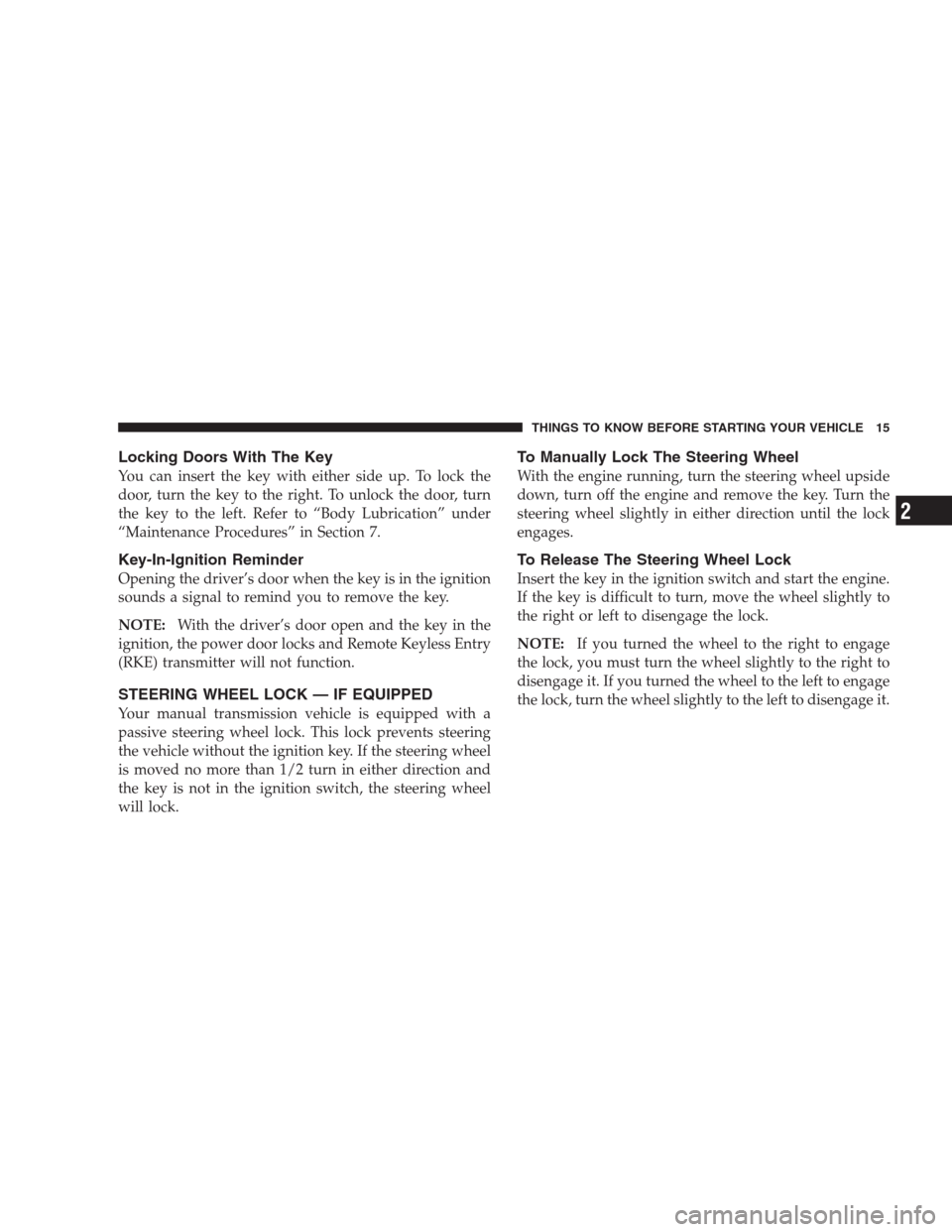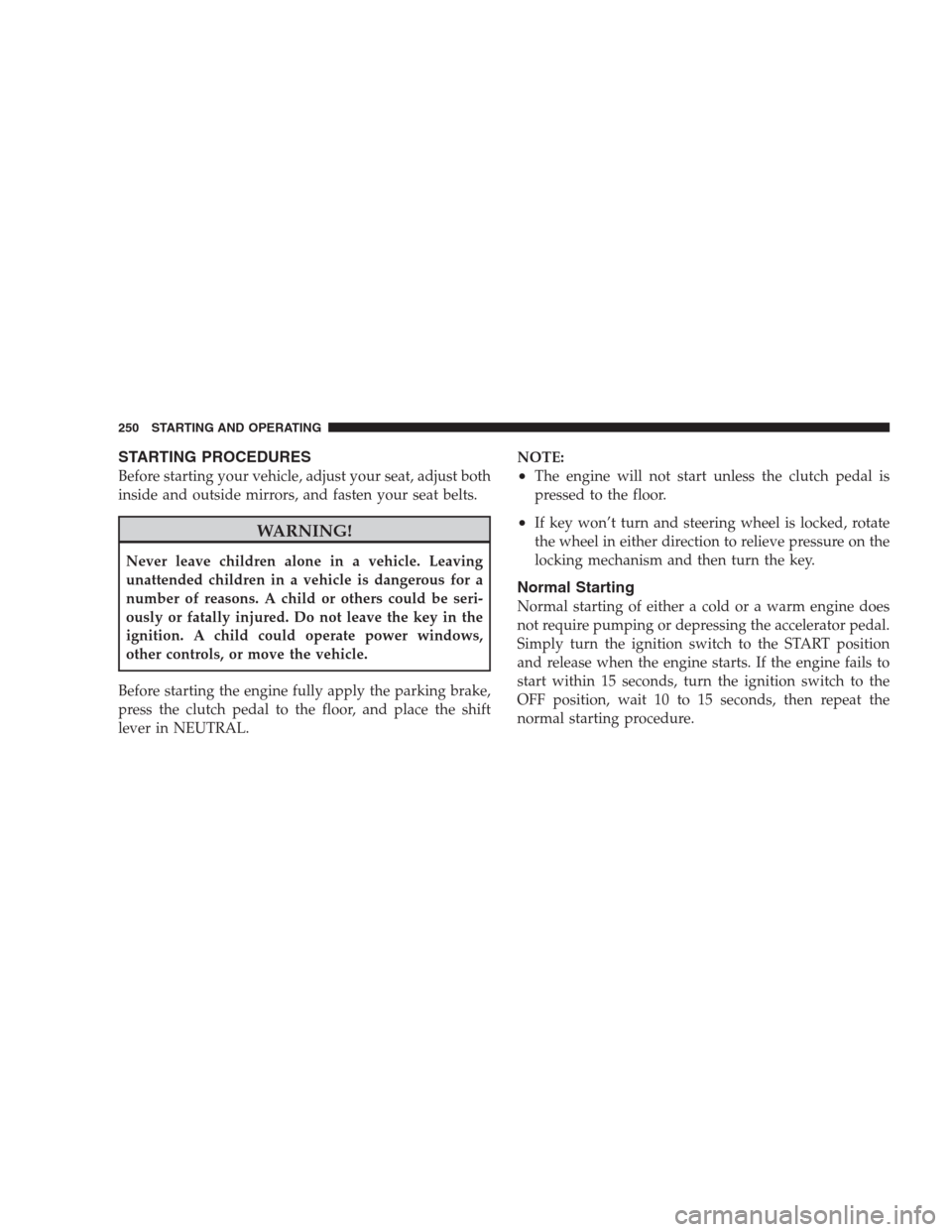Page 17 of 411

Locking Doors With The Key
You can insert the key with either side up. To lock the
door, turn the key to the right. To unlock the door, turn
the key to the left. Refer to “Body Lubrication” under
“Maintenance Procedures” in Section 7.
Key-In-Ignition Reminder
Opening the driver’s door when the key is in the ignition
sounds a signal to remind you to remove the key.
NOTE:With the driver’s door open and the key in the
ignition, the power door locks and Remote Keyless Entry
(RKE) transmitter will not function.
STEERING WHEEL LOCK — IF EQUIPPED
Your manual transmission vehicle is equipped with a
passive steering wheel lock. This lock prevents steering
the vehicle without the ignition key. If the steering wheel
is moved no more than 1/2 turn in either direction and
the key is not in the ignition switch, the steering wheel
will lock.
To Manually Lock The Steering Wheel
With the engine running, turn the steering wheel upside
down, turn off the engine and remove the key. Turn the
steering wheel slightly in either direction until the lock
engages.
To Release The Steering Wheel Lock
Insert the key in the ignition switch and start the engine.
If the key is difficult to turn, move the wheel slightly to
the right or left to disengage the lock.
NOTE:If you turned the wheel to the right to engage
the lock, you must turn the wheel slightly to the right to
disengage it. If you turned the wheel to the left to engage
the lock, turn the wheel slightly to the left to disengage it.
THINGS TO KNOW BEFORE STARTING YOUR VEHICLE 15
2
Page 74 of 411
Periodic Safety Checks You Should Make Outside
The Vehicle
Tires
Examine tires for excessive tread wear or uneven wear
patterns. Check for stones, nails, glass, or other objects
lodged in the tread. Inspect tread and sidewall for cuts or
cracks. Check the wheel nuts for tightness. Check the
tires (including spare) for proper pressure.
Lights
Have someone observe the operation of exterior lights
while you work the controls. Check turn signal and high
beam indicator lights on the instrument panel.
Fluid Leaks
Check the area under the vehicle after overnight parking
for fuel, engine coolant, oil or other fluid leaks. Also, if
gasoline fumes are detected or fuel, power steering fluid,
transmission fluid or brake fluid leaks are suspected, the
cause should be located and corrected immediately.
72 THINGS TO KNOW BEFORE STARTING YOUR VEHICLE
Page 77 of 411

�Windshield Wipers And Washers.......... 127
▫Windshield Wiper Operation............ 127
▫Intermittent Wiper System.............. 128
▫Windshield Washers................... 128
▫Mist Feature........................ 129
�Tilt Steering Column................... 130
�Electronic Speed Control — If Equipped...... 131
▫To Activate......................... 131
▫To Set At A Desired Speed.............. 132
▫To Deactivate....................... 132
▫To Resume Speed.................... 132
▫To Vary The Speed Setting.............. 132
▫Manual Transaxle.................... 133▫To Accelerate For Passing............... 133
�Garage Door Opener — If Equipped........ 134
▫Programming HomeLink�.............. 135
▫Gate Operator/Canadian Programming..... 138
▫Using HomeLink�.................... 138
▫Reprogramming A Single HomeLink�
Button............................ 139
▫Security........................... 139
▫Troubleshooting Tips.................. 139
▫General Information................... 140
�Power Sunroof — If Equipped............. 140
▫Opening The Sunroof.................. 141
▫Closing The Sunroof.................. 142
UNDERSTANDING THE FEATURES OF YOUR VEHICLE 75
3
Page 154 of 411
REAR WINDOW FEATURES
Rear Window Wiper/Washer
A switch on the right side of the steering column controls
operation of the rear wiper/washer function. Rotating
the center of the switch forward to the on position will
activate the wiper. The rear wiper operates in an inter-
mittent mode only. Rotating the center of the switch all
the way forward will turn on the wash function. The
wash pump will continue to operate as long as the button
is pressed. Upon release, the wipers will cycle two times
before returning to the set position.
If the rear wiper is operating when the ignition is turned
OFF, the wiper will automatically return to the “Park”
position if power accessory delay is active. Power acces-
sory delay can be cancelled by opening the door, if this
happens the rear wiper will stop at its current position
and will not go to park.
Rear Wiper/Washer Control
152 UNDERSTANDING THE FEATURES OF YOUR VEHICLE
Page 249 of 411
STARTING AND OPERATING
CONTENTS
�Starting Procedures.................... 250
▫Normal Starting..................... 250
▫Extremely Cold Weather (Below -20°F Or
-29°C)............................. 251
▫If Engine Fails To Start................. 251
▫After Starting....................... 252
▫Turbocharger “Cool Down”............. 252
�Manual Transaxle...................... 252
▫Downshifting....................... 253�Driving On Slippery Surfaces............. 254
▫Acceleration........................ 254
▫Traction........................... 254
�Driving Through Water.................. 255
▫Flowing/Rising Water................. 255
▫Shallow Standing Water................ 255
�Power Steering........................ 257
▫Power Steering Fluid Check............. 258
�Parking Brake........................ 259
5
Page 252 of 411

STARTING PROCEDURES
Before starting your vehicle, adjust your seat, adjust both
inside and outside mirrors, and fasten your seat belts.
WARNING!
Never leave children alone in a vehicle. Leaving
unattended children in a vehicle is dangerous for a
number of reasons. A child or others could be seri-
ously or fatally injured. Do not leave the key in the
ignition. A child could operate power windows,
other controls, or move the vehicle.
Before starting the engine fully apply the parking brake,
press the clutch pedal to the floor, and place the shift
lever in NEUTRAL.NOTE:
•The engine will not start unless the clutch pedal is
pressed to the floor.
•If key won’t turn and steering wheel is locked, rotate
the wheel in either direction to relieve pressure on the
locking mechanism and then turn the key.
Normal Starting
Normal starting of either a cold or a warm engine does
not require pumping or depressing the accelerator pedal.
Simply turn the ignition switch to the START position
and release when the engine starts. If the engine fails to
start within 15 seconds, turn the ignition switch to the
OFF position, wait 10 to 15 seconds, then repeat the
normal starting procedure.
250 STARTING AND OPERATING
Page 259 of 411

WARNING!
•Driving through standing water limits your vehi-
cle’s traction capabilities. Do not exceed 5 mph
(8 km/h) when driving through standing water.
•Driving through standing water limits your vehi-
cle’s braking capabilities, which increases stop-
ping distances. Therefore, after driving through
standing water, drive slowly and lightly press on
the brake pedal several times to dry the brakes.
•Getting water inside your vehicle’s engine can
cause it to lock up and stall out, and leave you
stranded.
•Failure to follow these warnings may result in
injuries that are serious or fatal to you, your
passengers, and others around you.
POWER STEERING
The standard power steering system will give you good
vehicle response and increased ease of maneuverability
in tight spaces. The system will provide mechanical
steering capability if power assist is lost.
If for some reason the power assist is interrupted, it will
still be possible to steer your vehicle. Under these condi-
tions, you will observe a substantial increase in steering
effort, especially at very low vehicle speeds and during
parking maneuvers.
NOTE:Increased noise levels at the end of the steering
wheel travel are considered normal and do not indicate
that there is a problem with the power steering system.
Upon initial start-up in cold weather, the power steering
pump may make noise for a short amount of time. This is
due to the cold, thick fluid in the steering system. This
noise should be considered normal, and it does not in any
way damage the steering system.
STARTING AND OPERATING 257
5
Page 260 of 411

WARNING!
Continued operation with reduced power steering
assist could pose a safety risk to yourself and others.
Service should be obtained as soon as possible.
CAUTION!
Prolonged operation of the steering system at the end
of the steering wheel travel will increase the steering
fluid temperature and it should be avoided when
possible. Damage to the power steering pump may
occur.
Power Steering Fluid Check
Checking the power steering fluid level at a defined
service interval is not required. The fluid should only be
checked if a leak is suspected, abnormal noises areapparent, and/or the system is not functioning as antici-
pated. Coordinate inspection efforts through an autho-
rized dealer.
No chemical flushes should be used in any power
steering system; only the approved lubricant may be
used.
WARNING!
Fluid level should be checked on a level surface and
with the engine off to prevent injury from moving
parts and to ensure accurate fluid level reading. Do
not overfill. Use only manufacturer’s recommended
power steering fluid.
If necessary, add fluid to restore to the proper indicated
level. With a clean cloth, wipe any spilled fluid from all
surfaces. Refer to “Fluids, Lubricants, and Genuine
Parts” in Section 7 for the correct fluid type.
258 STARTING AND OPERATING